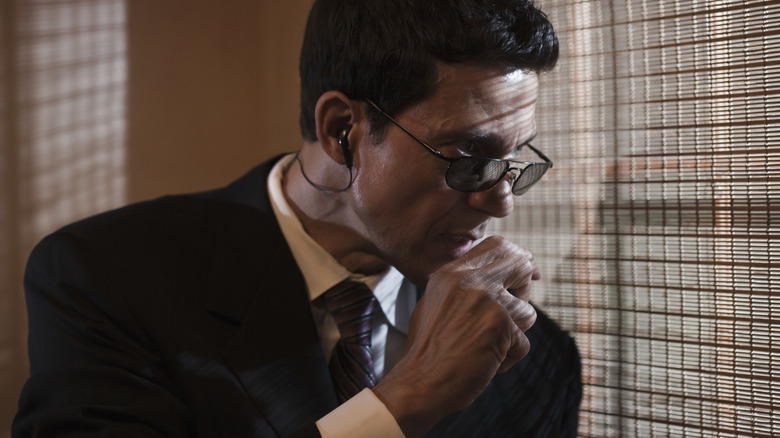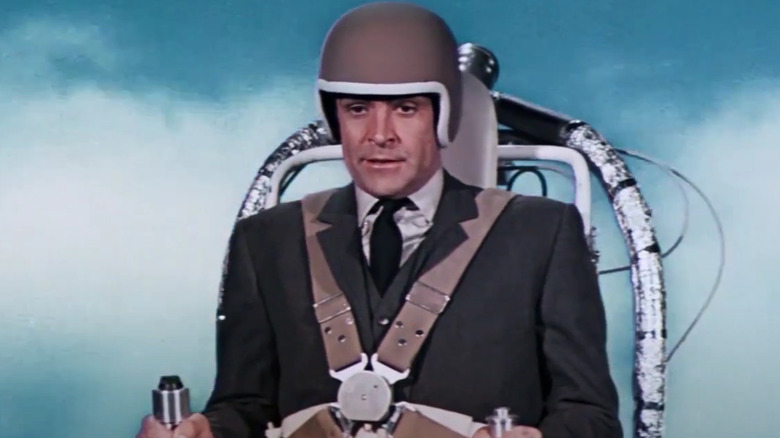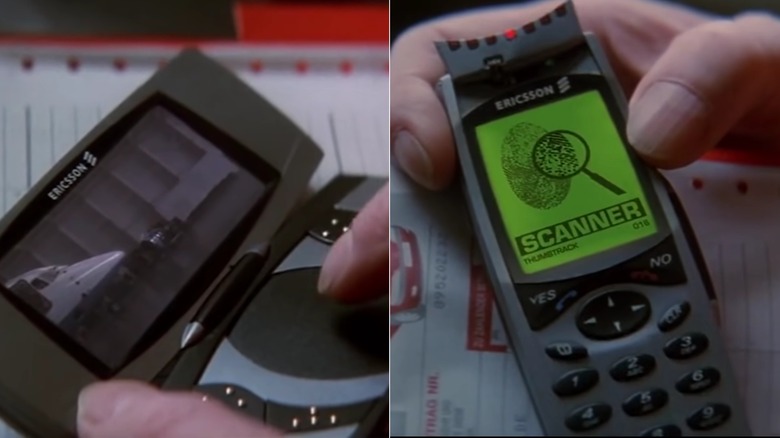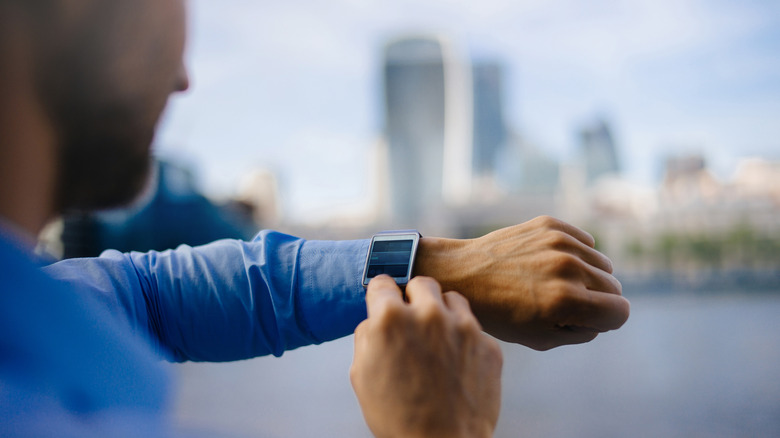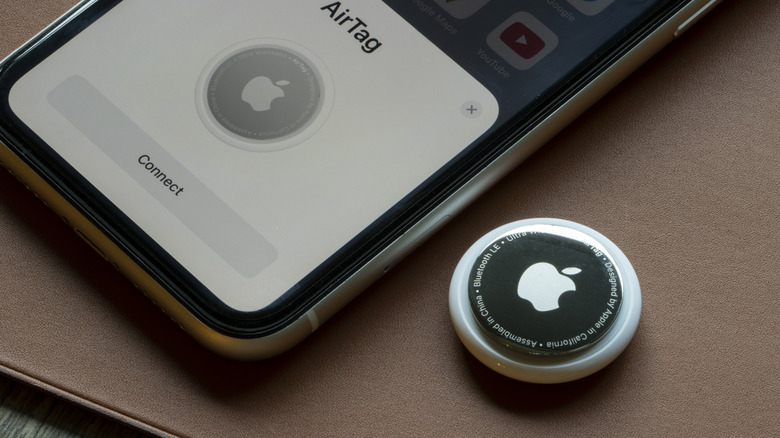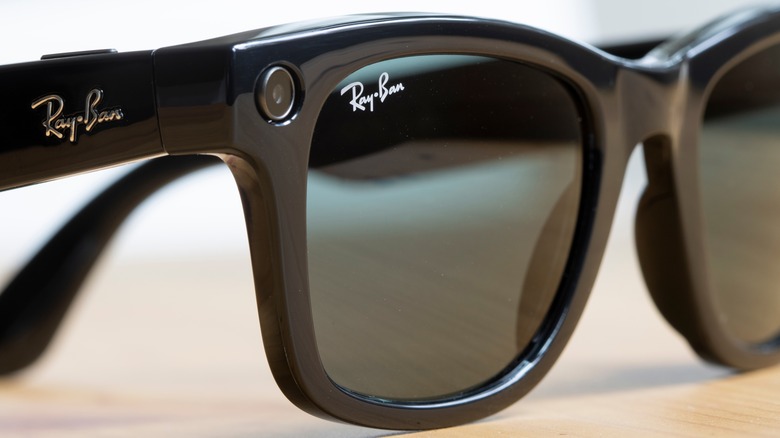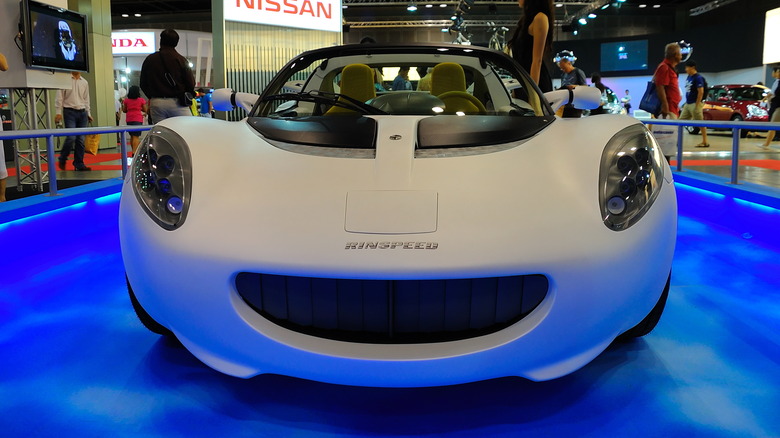6 Spy Movie Gadgets That Became A Reality
From James Bond to Ethan Hunt, there are a good number of spies on the big screen who have used multiple high-tech gadgets to accomplish their objectives. Sometimes these gadgets are too far-fetched that they can never become a reality, like maybe an invisible car or a cigarette gun — not that there aren't those out there trying. However, sometimes reality catches up with fiction, and those far-fetched notions of ingenuity become a regular consumer product or an experimental project for the military.
It's not uncommon for movie magic to leap from the big screen and into consumers' laps. Real world technology has even caught up with old-school "Star Wars" tech. At least some gadgets spies use are a little more plausible. No, nobody is walking around with a laser in their watch, as cool as that would be, but watches today are capable of much more than displaying the time. Several everyday items that we take for granted can be seen in older films helping the hero gather intelligence or escape from sticky situations. You might already own some of these gadgets — ones available to the general public, that is.
Jetpacks were the clandestine mode of transportation
A jetpack might not seem like a gadget a spy would use. Spies are supposed to be quiet, secretive, under the radar, and jetpacks are the opposite of all that. Not only would they be loud, but seeing a man zipping around in midair is anything but discreet. They also don't fit in your back pocket. Covert operatives need items that are easily accessible, but that didn't stop James Bond from using one in 1965's "Thunderball," and kids everywhere have wanted one ever since.
In 2017, a man by the name of Richard Browning — founder of Gravity Industries — built his own jetpack and broke a speed record with it (32 mph). Granted, his design is based more on "Iron Man's" suit where boosters are equipped to the hands as a means to balance the pilot. That's not the only jetpack that's been in production, though.
In fact, Popular Science has been tracking the development of jetpacks throughout the years where numerous designs have taken shape. The U.S. Army funded the rocket belt project back in the '60s, bringing humans even closer to having real-life jetpacks. The problem was that the jetpack couldn't sustain a flight longer than 20 seconds, or fly faster than 15 mph. The idea of jetpacks never faded, and now there are potential military applications for them. Jetpacks are rising in enough popularity these days that the Dubai Sports Council, along with Gravity Industries, organized the world's first jetpack race.
Smartphones are a spy's best friend
Pierce Brosnan's James Bond used a phone in 1997's "Tomorrow Never Dies" that came with a fingerprint scanner and could remotely control his BMW 750. It was certainly a phone ahead of its time, but now, mobile phones with multiple functions are a dime a dozen, and the old James Bond gadget wouldn't remotely impress audiences today. Granted, nobody's smartphone can tase anyone, which is another feature Bond's phone had. This wasn't the first time audiences saw a spy on the silver screen use an advanced phone like this, though.
Smartphones, being the Swiss Army knives of technology that they are, are featured in every modern day spy film. They're used for GPS tracking, monitoring cameras, sending and receiving encrypted messages, and keeping things secured behind a fingerprint scan. Unlike the James Bond phone, which scanned fingerprints with the intention of breaking into secure locations, a real smartphone's fingerprint scanner typically acts as a security measure to keep intruders away from sensitive material. It's safe to say that the real-life device has surpassed Hollywood's imagination.
Smartwatches are mainstream now
Communication devices are vital in the world of intelligence gathering, and Hollywood was always creative with their methods for undercover agents to communicate with their handlers. Most common was a watch because, they were once unassuming. Before mobile phones, almost everyone wore a time piece of some sort — analogue or digital. Before Apple debuted the Apple Watch, the "Spy Kids" had watches that could connect to satellites, the internet, and let them watch TV, which is considerably closer to reality than other iterations of smartwatches in cinema. Most versions of a "smartwatch" allowed characters to merely transmit and receive communications like a walkie-talkie.
Nowadays, these little wearables are capable of so much more, exceeding the imaginations of Hollywood's most creative writers. They keep track of the wearer's steps, act as a heart rate monitor, make it easier to pay for goods, help with navigation, and so much more that's easily taken for granted. Furthermore, a large fraction of the world is familiar with the ins and outs of smartwatches. According to Demand Sage, as of 2024, over 220 million consumers own and use a smartwatch. They're no longer a work of fiction.
Tracking devices have become a common consumer item
It wasn't uncommon for an undercover agent to plant a tracking device on a villain's vehicle or even on their person. These tracking devices took various forms, but they were always as small as a button. Something that seemed too advanced for anyone other than government operatives to use is now common place. Of course, most people use them to prevent themselves from misplacing their wallet, keys, or some other innocuous item. What are these consumer-grade tracking devices? Apple's AirTag, and other similar gadgets like the Tile.
These little gadgets send a Bluetooth signal to a phone, showing the user where the device is located on a map. Unfortunately, that's a little too much power for a person to have sometimes — sometimes it's the villain doing the tracking against our hero. While Apple and other developers intend for the trackers to be used on household items, some misguided individuals have taken advantage of the devices. There was a class-action lawsuit against Apple in 2022 after bad actors used AirTags to stalk and harass two women.
This wasn't the only instance of AitTags being used nefariously. Apple eventually instituted safeguards and worked with law enforcement on all AirTag-related incidents. Be safe and use AirTags and similar devices with responsibility.
Smart glasses have almost caught up with Hollywood
Watching Ethan Hunt or James Bond run around with a pair of glasses that displays pertinent information is something everyday people would love to have. It also looks really cool: From x-ray specs to facial recognition, different spies in cinema have used smart glasses for multiple purposes. Imagine wearing a pair of glasses that automatically displays traffic conditions, negating the need to fumble with your phone. Of course, smart glasses aren't quite where Hollywood imagines they would be.
They aren't capable of displaying contextual data like the name of a building you're looking at, and very few real-life designs have a wire frame. Smart glasses are typically bulky in order to accommodate the cameras and other tech built into them. The market for smart glasses has gotten off to a slow start because many consumers aren't fans of the way the products look. The closest to common glasses a company has been with its smart glasses design has been Ray-Ban with its Ray-Ban Stories. However, even those aren't real smart glasses that tap into augmented reality. They can take photographs, record videos, and answer and place phone calls via Bluetooth.
While that's useful, it's a little limited compared to what people want from smart glasses. Nowadays, to stay at the margins of reality, movies have featured advanced contact lenses that can do everything movies once imagined smart glasses could do. Perhaps reality will catch up with this technology down the road.
Honorable mention to sQuba, the first submersible car - sort of
In 1977's "The Spy Who Loved Me," Roger Moore as James Bond drove a Lotus Esprit Turbo — now owned by Elon Musk — that could double as a submersible. While it's not really a gadget everyday John Q can own, a fan of the idea did turn it into the real deal. Through the creativity of its CEO and die hard James Bond fan, Rinspeed unveiled the world's first submersible car in 2008 in honor of the 1977 film. Aptly called sQuba — the "Q" a reference to Bond's quartermaster — this experimental convertible can seamlessly go from driving on the road at 77 mpg to submerging below the waterline, continuing down as deep as 30 feet at 1.8 mph.
Did we say convertible? Yes, that's the one caveat. For safety reasons, CEO Frank Rinderknecht designed the car as a convertible to allow passengers to evacuate the vehicle immediately in case of an emergency. Not exactly identical to the Lotus Esprit Turbo that Roger Moore dove off a dock in '77. It also doesn't have torpedoes or any other weapons on board, of course. What it does have, however, is an integrated oxygen tank so the driver and passenger can remain in the car while it's underwater. There's just no way for a real life James Bond to use this car without showing up to a diplomatic gala in a dry tuxedo.
